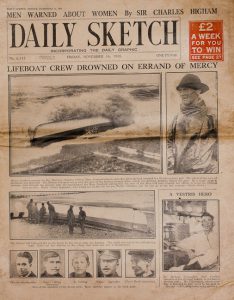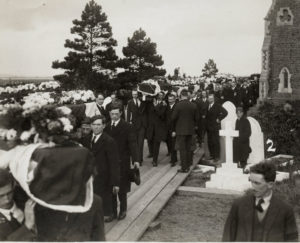Early in the morning of November 15, 1928, Rye Harbour Lifeboat the ‘Mary Stanford’ was launched in order to assist a stricken vessel.

The ‘SS Alice’, a small Latvian vessel out of the port of Riga, was in difficulty off Dungeness. The weather conditions at the time were among the worst in living memory. Frank Saunders was a launcher on that fateful day and recalled that it was a dark and wild morning when they went to assist the launch, blowing a full gale from south south-east.
The maroon was fired at 5am. A member of the crew observed that you couldn’t see across the marsh because of the spray from the water. It wasn’t fog, just the spray from the shallow breaking waves.

It was low water and they had great difficulty in launching the boat. There was a stretch of sand to pull the boat across and it took three attempts before she was afloat. The crew had to get in the craft after launching and they were, as a consequence, drenched through before they set off.
She had only been afloat a matter of seconds when a message came through recalling the boat as her services were no longer required. The signalman, Mr. Mills, fired his recall flare and Frank Saunders ran across the sands into the water to try to attract the attention of the crew. The weather was atrocious and they were too occupied in getting the sails set to notice.

‘Mary Stanford’ was a pulling and sailing type lifeboat. She had no engines and radio, none of the devices that today we regard as commonplace. With a fifteen-foot oar in their hands and sails to set in a gale it is no wonder that they did not see the re-call signal.
What happened between setting sail and her capsize we will never know, as all seventeen hands on board lost their lives.
Villagers at the time recall the devastating sight of the vicar, Rev. Harry Newton, kneeling on the beach praying with the women of the village. Hardly a family in the community of 200 escaped the effect of the tragedy – the worst in British Lifeboat history. Eventually the bodies were brought back to the harbour and put in the Fisherman’s Room: Harry Cutting and young John Head were still missing. All the coffins lay side-by-side with just the words ‘Died Gallantly’ placed on each one.

Ninety years ago a Sussex Express reporter wrote:
‘The simple funeral service invested with a solemn dignity, left a memory that shall become a greater memorial to the sacrifice of Rye Harbour, that any monument of stone would ever be.’
The Mayor of Rye, Mr. Vidler, launched an appeal for monies for the families which went world-wide. Donations came in from all corners of the globe.
The day of the funeral arrived and it was the biggest known in these parts. There were over a thousand wreaths laid. The people attending were so numerous that the service took place in the churchyard.
The crew of the lifeboat had worked together, laughed together and died together and now they were buried together. The village was in mourning for a very long time having lost so many of their menfolk.
Image Credits: Rye Harbour.net , RNLI , Daily Sketch .



